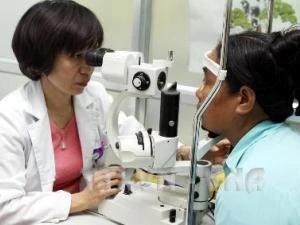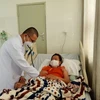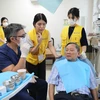Can Tho (VNA) - Experts have warned that HCM City and the Mekong Delta region are witnessing a worrying uptick in the number of diabetic patients, and with this, a heightened risk of diabetic eye diseases (diabetic retinopathy).
In the next five years, diabetes patients in HCM City and adjacent localities will be provided with free eye care under a 734.000 USD project jointly funded by the international NGO Orbis and the World Diabetes Foundation.
This was announced at the National Ophthalmology Conference held in Can Tho city last week.
Chronically high blood sugar from diabetes devastates the whole body’s microvascular system, which includes tiny blood vessels that nourish the retina, doctors said at the conference.
The arteries in the retina deteriorate and begin to leak, forming small, spot-like hemorrhages (blood flow from the broken blood vessel). At an early stage, vision may be normal or may have started to blur or change, then it starts to get progressively worse as more blood vessels are damaged.
Overlooked risk
What many diabetic patients fear most are risks of acute complications such as strokes or heart attack. Diabetes-related eye defects - despite being a serious complication - their insidious nature made these diseases easily overlooked by patients.
Once the symptoms of vision loss (blurriness, flashes, black spots, etc.) start to appear, it could be ‘incurably’ late.
However, Tran Thi Phuong Thu, former Director of HCM City’s Hospital of Ophthalmology, said the silver lining is that early preventive screening and treatment can considerably reduce the risk and severity of vision impairments caused by diabetes.
Nguyen Xuan Hiep, Deputy Chief of the National Steering Committee on Blindness Prevention, said that in 2015, hospitals nationwide examined some 23,330 diabetic patients, of which 12,780 (or nearly 55percent) were diagnosed with eye problems as a result of diabetes.
Hiep also noted that the number of patients examined only accounted for 2.52 percent of all diabetic retinopathy patients who need regular checkups and treatment. This means many more people are exposed to elevated risks of blindness that could be otherwise precluded, or at least alleviated, he said.
Aside from patients’ heedlessness, medical facilities also do not give this serious complication the attention that it needs, the conference heard.
Many facilities have not formulated a specific diagnosis and treatment regime for patients with diabetes, and eye tests are usually skipped.
A survey by the Ministry of Health (Moh) found that in Vietnam, up to 6 in 10 diabetic patients didn’t receive checkups and proper treatment.
An appropriate management model that effectively keeps track of all diabetic patients is also lacking, while the number of healthcare staff trained in eye-care is severely limited, experts said at the conference.
Early detection
Under the new project, the Department of Clinical Management (under MoH), National Hospital of Ophthalmology and National Hospital of Endocrinology will consolidate policies that aim to improving the quality of screenings with regard to diabetes-related eye diseases.
These agencies will also develop a cooperation mechanism that allows and simplifies transferring of patients between ophthalmology and endocrinology departments.
A proposal is being prepared to include preventive eye disease examinations under universal healthcare regimes (paid for by healthcare insurance).
Experts said that raising public awareness in general and that of diabetic patients in particular about the potential risks of blindness from diabetes is an important task that would help curb the spread of the disease.-VNA























